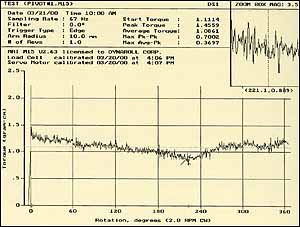| Available Bearings | Bearing Selector | Technical Info | New Products | |||
Ball Bearing Torque Information || Dynaroll
TECHNICAL INFORMATION
TECHNICAL INFO
Overview & Nomenclature
Materials
Cages/Retainers
Shields and Seals
Ball Bearings - Geometry
Ball Bearings - Tolerances
Ball Bearings - Lubrication
Load Rating and Bearing Lifetime
Ball Bearings - Torque
Ball Bearings - Noise
Mounting and Fitting
Assembly Preload
Ball Bearing Handling
Adhesive Practices
Assembly Characteristics
Useful Conversions
Interested in Mechanical Assemblies?
 Visit our Assemblies Section
Visit our Assemblies Section
Read our Quality Policy
Overview & Nomenclature
Materials
Cages/Retainers
Shields and Seals
Ball Bearings - Geometry
Ball Bearings - Tolerances
Ball Bearings - Lubrication
Load Rating and Bearing Lifetime
Ball Bearings - Torque
Ball Bearings - Noise
Mounting and Fitting
Assembly Preload
Ball Bearing Handling
Adhesive Practices
Assembly Characteristics
Useful Conversions
Interested in Mechanical Assemblies?
Read our Quality Policy
BEARING TORQUE
Small diameter (< 20 mm O.D.) deep groove ball bearings have extremely low and uniform torque characteristics. Even when preloaded as part of an assembly, average torque levels of less than 0.5 gm-cm (0.007 oz-in) are common. Typically, torque is dependent on many factors, including ball size, number of balls, retainer type and looseness, radial play, lubricant type and fill percentage, and applied load.
 M15 Torque Tester Screenshot |
For more information and a discussion on bearing torque and torque analysis, see Assembly Characteristics.
BEARING TORQUE FACTORS
FACTOR |
TORQUE EFFECT |
Ball size |
Smaller gives lower torque |
Number of balls |
Fewer gives lower torque |
Retainer |
Crown gives lower torque, loose clinch for ribbon type gives lower torque |
Radial play |
Higher gives lower torque |
| Lubricant | Higher viscosity gives higher torque |
| Lubricant fill | Higher percentage gives higher torque |
| Applied load | Higher load gives higher torque |
| The chart below can be used as a simple guide to expected average torque levels for individual bearings with oil lubricant, however, the user must be cautioned that real-life torque values will vary considerably according to the application. | |
AVERAGE BEARING TORQUE (GM-CM)
DYNAROLL BEARING SIZE (Inches Series) |
RETAINER TYPE |
BALL
SIZE Inch (mm) |
#
BALLS |
THRUST
LOAD (gm) |
MAX.
AVG. TORQUE (gm-cm), OIL LUBE @ INDICATED THRUST |
||
RADIAL
PLAY Inches (mm) |
|||||||
MC2 .0001-.0003 .002-.008 |
MC3 .0002-.0004 .005-.010 |
MC5 .0005-.0008 .013-.020 |
|||||
09,0,1,1-4, 1-5 144,
155, 156, 168 |
Crown (W) |
<1/16 |
<13 |
75 |
.18 |
.15 |
.14 |
2-5 |
Ribbon (J) |
1/16 |
6 |
75 |
.18 |
.15 |
.14 |
2-6, 2, 166 |
Ribbon (J) |
1/16 |
<8 |
75 |
.2 |
.16 |
.15 |
188 |
Ribbon (J) |
2 |
8 |
400 |
.63 |
.54 |
.49 |
3 |
Ribbon (J) |
3/32 |
7 |
400 |
.65 |
.55 |
.5 |
4 |
Ribbon (J) |
3/32 |
8 |
400 |
.7 |
.6 |
.55 |
